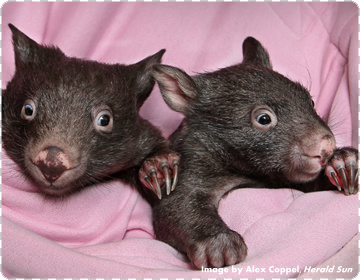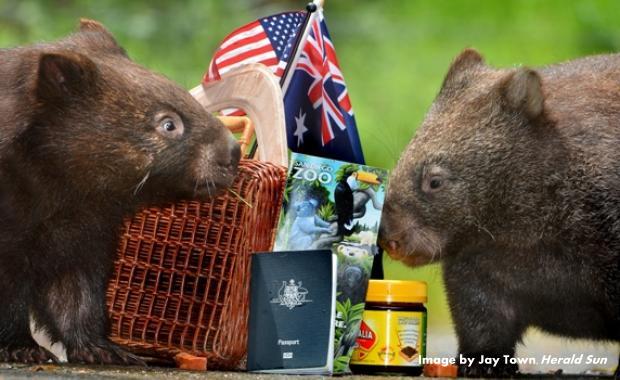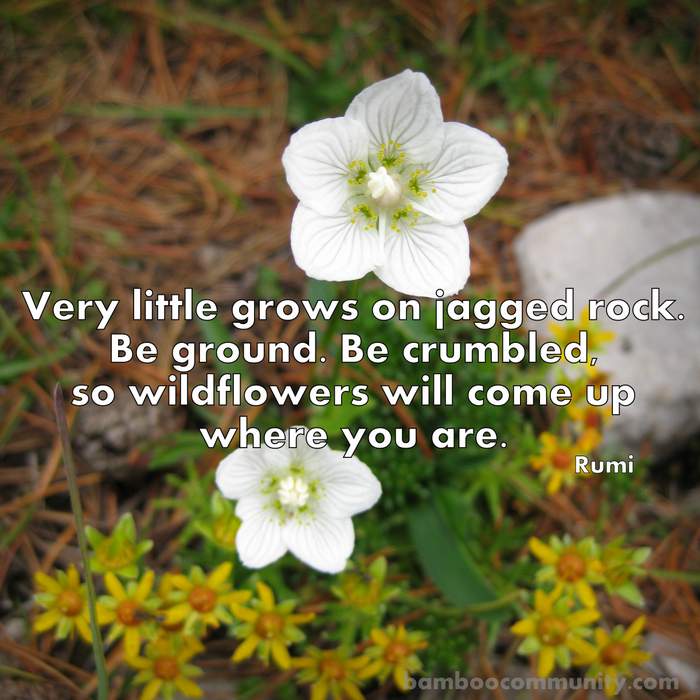the story of phoenix
By Donna Sutton
I don’t want to tell you about a phoenix, a mythological bird that dies in flames, only to rise with renewed youth to live again. I want to tell you about Phoenix, a baby wombat from Lancefield who, together with her friend, Belle, are star attractions at the San Diego Zoo, in California, USA.
Phoenix’s mother lived near the corner of Red gap Road and West Goldie Roads, Lancefield. Mike, my neighbour, enjoyed her too; lumbering along the banks of Spring Creek, through her tunnels, under the road bridges. If I were very quick, before I turned up Red Gap Road, I could sometimes catch a glimpse of her disappearing back under the road, into her tunnel, under the road bridge. She was very shy and beautiful. She had the longest whiskers of any ‘Common Wombat’.
Jogging one dawn in early July, 2011, something was wrong. Phoenix’s mother remained in the middle of the road; no scampering off the road bridge this morning. I ran and stood with her. She had been hit by a vehicle and died. Instantly. I know she died immediately, as she still had a blade of grass clamped in her mouth; frozen. She had died above the road tunnel, on Red Gap Road. Later that day, children on the school bus dropped an apple for her; that was kind.
As I pulled her off to the grass on the side of the road, where she would be safe from further harm, there appeared a little wriggling, gurgling, black haired Phoenix, alive, warm and snug in her mother’s pouch. Not happy, but bruised and hurt. At around seven o’clock in the morning, the Healesville Sanctuary Hospital emergency nurse told me what to do.
In case you ever have the chance to save a marsupial, I will tell you what the nurse told me:
1. You must find out if the mother is dead or can be saved. So, FIRSTLY: IS THE MOTHER DEAD?
Yes. It was clear that Phoenix’s mother was dead because her feet were up in the air. There was no breathing, no a heartbeat.
2. SECONDLY: REMOVE THE BABY WOMBAT FROM THE POUCH
STEP ONE: Removing Phoenix from the pouch. Is she still attached tightly to her mother’s teat inside the pouch?
No. Phoenix was attached to her mother’s teat but she let go easily with a gentle tug.
STEP TWO: Put your hand inside the pouch membrane. Ease Phoenix out of the pouch.
This was a little scary, but I was surprised. I eased my hand around Phoenix. The pouch was dry and warm, black and smooth; a taut, hairless membrane was holding Phoenix very snugly to her mother’s tummy. It was hard to put my fingers around Phoenix’s back. But I did. I eased Phoenix, grumbling and warm out of the pouch.
3. CAN YOU BRING HER TO THE HOSPITAL?
Yes. Phoenix, wrapped in my jogging jumper, was dry and warm. In a pretend pouch shape, inside my jacket, she could hear another heart beating; she was not alone.
It wasn’t even opening hours at the Healesville Sanctuary Hospital when we arrived, but we were expected, gates opened. In the Emergency Room, the vet nurse was very gentle. She had a new, warm, woollen pouch, (especially knitted by helpers of the Sanctuary) ready. Phoenix needed to be weighed first before she could be plopped into her new, warm, woollen pouch. She weighed 300 grams, smaller than the palm of an adult’s hand. She was five months old and had a healthy shock of black hair. This gave this premature baby a chance of survival. Was she developed enough ? Would she survive?
The veterinarian looked carefully at this baby wombat. He checked her for broken bones, bruising and cuts. He found Phoenix was a strong little female wombat, who had been looked after well by her mother. She had cuts, which needed stitches during surgery, as well she had a lot of bad bruising but nothing was broken. Her mother had taken the full force of the vehicle. So, Phoenix had surgery, and the wounds were stitched and she was given antibiotics to help her fight the deadly infections which may come. Phoenix was prescribed four-hour feeds of special wombat formula. She would travel to and from the Sanctuary daily, in her woollen pouch, with her carer. How kind her carer must be to wakeup in the night, every night for months to feed Phoenix her unique formula every few hours?
Infection was not the major concern. Phoenix survived the stitches and shock. The antibiotics were reducing the infection, but her chances of survival doubled when Belle, another orphaned wombat, was brought into the Sanctuary. They could help each other. And that is what they did. At night Phoenix and Belle would go home with their carers, but during the day they would play and sleep together; they were not alone.
Phoenix and Belle grew and grew. People came to Healesville Sanctuary to see them. They had their photos in the newspapers. But that is not the end of their story. The San Diego Zoo in the United States of America is one of the great zoos in the world. They wanted two beautiful wombats for their children to get to know too.


